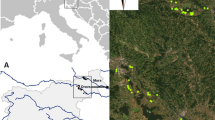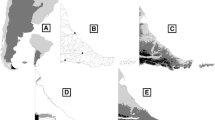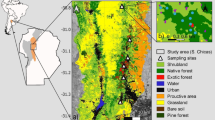Abstract
A floristic survey has been carried out in a peri-urban forest, the Sonian Forest in Brussels, to identify indicator plant species in the herbaceous layer, which could be used as an aid within the framework of a more sustainable management of the forest. Three hundred and seventy two (372) taxa have been identified, 33 of which are non-native (i.e. non-indigenous species regarding the study area, whether invasive or not). Criteria of habitat quality that have been chosen are the species richness, the commonness of the habitat, based on constitutive species, and its invasibility (vulnerability for invasion). On the basis of a comparison of the value of these criteria when each considered (potential indicator) species is present or not, 17 species have been recognised as reliable indicators of at least one of these three criteria. In particular, vegetation types containing either Anthriscus sylvestris, Galeopsis tetrahit or Senecio ovatus were found to be more susceptible to invasion than other habitats. The way to how the predictability of invasions might be effectively used as a management tool is discussed. Furthermore, we found a positive significant correlation (Bonferroni corrected probabilities) between the species richness and luminosity factor (derived from Ellenberg's indices), and the proportion of grassland and wetland species. The species richness was significantly negatively correlated with the proportion of woodland species. An increase in commonness was significantly correlated with a decrease in the proportion of geophytes. The usefulness of these results as an ecological basis for forest management is discussed.
Similar content being viewed by others
References
Airola T.M. and Buchholz K. 1984. Species structure and soil characteristics of five urban forests sites along the New Jersey palisades. Urban Ecology 8: 149–164.
Bormann F.H. and Likens G.E. 1979. Pattern and Process in a Forested Ecosystem. Springer, New York.
Braun-Blanquet J. 1932. Plant Sociology: The Study of Plant Communities. McGraw-Hill, New York.
Cajander A.K. 1926. The theory of forest types. Acta Forestalia Fennica 29: 1–108.
Cheke A.S. 1987. An ecological history of the Mascarene Islands, with particular reference to extinctions and introductions of land vertebrates. In: Diamond A.W. (ed.), Studies of Mascarene Islands Birds. Cambridge University Press, Cambridge, UK, pp. 5–89.
Coombe D.E. 1956. Biological Flora of the British Isles Impatiens parviflora DC. Journal of Ecology 44: 701–713.
Cronk Q.C.B. and Fuller J.L. 1995. Plant Invaders. Chapman & Hall, London.
Cwiklinski E. 1978. Die Einwanderung der Synanthropenart Impatiens parviflora DC. in die Naturlichen Pflanzengesellschaften. Acta Botanica Slovenica Series A 3: 17–33.
Dallmeier F. and Comiskey J.A. 1998. Forest biodiversity assessment, monitoring and evaluation for adaptive management. In: Dallmeier F. and Comiskey J.A. (eds), Forest Biodiversity Research, Monitoring and Modelling. UNESCO, Paris, pp. 3–15.
D'Antonio C.M., Hughes R.F., Mack M., Hitchcock D. and Vitousek P.M. 1998. The response of native species to removal of non-native grasses in a seasonally dry Hawaiian woodland. Journal of Vegetation Science 9: 699–712.
Dickson J.H. 1998. Plant introductions in Scotland. In: Lambert R.A. (ed.), Species History in Scotland. Introductions and Extinctions Since the Ice Age. Scottish Cultural Press, Edinburgh, Scotland, UK, pp. 38–44.
Doolittle W.T. 1969. Research in urban forestry. Journal of Forestry 67: 650–656.
Eissenstat D.M. and Caldwel M.M. 1988. Competitive ability is linked to rates of water extraction: a field study of two aridland tussock grasses. Oecologia 75: 1–7.
Ellenberg H. 1988.Vegetation Ecology of Central Europe. Cambridge University Press, Cambridge, UK.
Ellenberg H., Weber H.E., Dull R., Wirth V., Werner W. and Paulissen D. 1991. Zeigerwerte von Pflanzen in Mitteleuropa. Scripta Geobotanica 18: 1–248.
Godefroid S. 1995. Aperçu floristique de la foret de Soignes dans sa partie bruxelloise. Dumortiera 61–62: 7–21.
Godefroid S. 1996a. Mise en evidence de la richesse floristique d'une grande ville: le cas de Bruxelles-Capitale. Dumortiera 63: 19–30.
Godefroid S. 1996b. A propos de l'extension spectaculaire de Fallopia japonica, F. sachalinensis, Buddleja davidii et Senecio inaequidens en Région bruxelloise. Dumortiera 63: 9–16.
Gaodefroid S. 1998. Contribution a la connaissance de la distribution d'Heracleum mantegazzianum a Bruxelles. Dumortiera 72: 1–7.
Hobbs R.J. and Huenneke L.F. 1992. Disturbance, diversity and invasion. Implications for conservation. Conservation Biology 6: 324–337.
Honnay O., Degroote B. and Hermy M. 1998. Ancient-forest plant species in Western Belgium: a species list and possible ecological mechanisms. Belgian Journal of Botany 130: 139–154.
Hughes R.F. and Vitousek P.M. 1993. Barriers to shrub reestablishment following fire in a seasonal submontane zone of Hawaii. Oecologia 93: 557–563.
Kremen C. 1992. Assessing the indicator properties of species assemblages for natural areas monitoring. Ecological Applications 2: 203–217.
Lambinon J., De Langhe J.E., Delvosalle L. and Duvigneaud J. 1992. Nouvelle Flore de la Belgique, du Grand-Duché de Luxembourg, du Nord de la France et des Régions voisines (Peridophytes et Spermatophytes). Jardin Botanique national de Belgique, Meise, Belgium.
Lindenmayer D.B., Margules C.R. and Botkin D.B. 2000. Indicators of biodiversity for ecologically sustainable forest management. Conservation Biology 14: 941–950.
Macdonald I.A.W. 1994. Global change and alien invasions: implications for biodiversity and protected area management. In: Solbrig O.T., Van Emden H.M. and Van Oordt P.G.W. (eds), Biodiversity and Global Change. CAB International /IUBS, Paris, pp. 199–209.
Macdonald I.A.W., Loope L.L., Usher M.B. and Hamann O. 1989. Wildlife conservation and the invasion of nature reserves by introduced species: a global perspective. In: Drake J.A., Mooney H.A., di Castri F., Groves R.H., Kruger F.J., Rejmanek M. et al. (eds), Biological Invasions: A Global Perspective. Wiley, New York, pp. 215–255.
Mark S. and Lawesson J.E. 2000. Plants as indicators of the conservation value of Danish beech forests. Proceedings IAVS Symposium, Uppsala, Sweden, 26 July–1 August 1998. Uppsala, Sweden, pp. 158–161.
Marks P.L. 1974. The role of pin cherry (Prunus pensylvanica L.) in the maintenance of stability in northern hardwood ecosystems. Ecological Monographs 44: 73–88.
Mills L.S., Soulé M.E. and Doak D.F. 1993. The key-stone species concept in ecology and conservation. BioScience 43: 219–224.
Noirfalise A. 1984. Forêts et stations forestiéres en Belgique. Les Presses Agronomiques de Gembloux, Gembloux, Belgium.
Noss R.F. 1990. Indicators for monitoring biodiversity: a hierarchical approach. Conservation Biology 4: 355–364.
Parsons P. 1991. Biodiversity conservation under global climatic change: the insect Drosophila as a biological indicator? Global Ecology and Biogeography Letters 1: 77–83.
Peterken G.F. 1974. A method for assessing woodland flora for conservation using indicator species. Biological Conservation 6: 239–245.
Rejmanek M. and Richardson D. 1996. What attributes make some plant species more invasive? Ecology 77: 1655–1661.
Root R.B. 1967. The niche exploitation pattern of the blue-grey gnatcatcher. Ecological Monographs 37: 317–350.
Spellerberg I.F. 1994. Monitoring Ecological Change. Cambridge University Press, Cambridge, UK.
Stapanian M.A., Sundberg S.D., Baumdardner G.A. and Liston A. 1998. Alien plant species composition and associations with anthropogenic disturbance in North American forests. Plant Ecology 139: 49–62.
Stieperaere H. and Fransen K. 1982. Standaardlijst van de Belgische vaatplanten, met aanduiding van hun zeldzaamheid en socio-oecologische groep. Dumortiera 22: 1–41.
Tanghe M. and Froment A. 1968. Variabilite du tapis herbace de la chenaie-coudraie en fonction des caractéristiques édaphiques superficielles. Bulletin de la Societe Royale de Botanique de Belgique 101: 245–256.
Trepl L. 1984. Ñber Impatiens parviflora DC. als Agriophyt in Mitteleuropa. Dissertationes Botanicae 73. J. Cramer, Vaduz.
Usher M.B. 1989. Ecological effects of controlling invasive terrestrial vertebrates. In: Drake J.A., Mooney H.A., di Castri F., Groves R.H., Kruger F.J., Rejmanek M. et al. (eds), Biological Invasions: A Global Perspective. Wiley, New York, pp. 463–489.
van Rompaey E. and Delvosalle L. 1979. Atlas de la flore belge et luxembourgeoise, Pteridophytes et Spermatophytes. Jardin Botanique National de Belgique, Meise, Belgium.
Wulf M. 1997. Plant species as indicators of ancient woodland in northwestern Germany. Journal of Vegetation Science 8: 635–642.
Rights and permissions
About this article
Cite this article
Godefroid, S., Koedam, N. Identifying indicator plant species of habitat quality and invasibility as a guide for peri-urban forest management. Biodiversity and Conservation 12, 1699–1713 (2003). https://doi.org/10.1023/A:1023606300039
Issue Date:
DOI: https://doi.org/10.1023/A:1023606300039




